Law & Order URI

Why do women work in the tough field of corrections, so often seen as a man’s world?
For one URI alumna, an undergraduate internship at the maximum-security facility left an impression that she couldn’t shake; for another, it was a post-college internship at the Training School. Others worked with runaways, or took classes taught by a recovering addict. However unique their motivations, these remarkable women, URI graduates of the 1970s, 80s, 90s, and 2000s—and the professors who taught them—have chosen the incredibly challenging, often frustrating professional path of working with incarcerated men and women at Rhode Island’s Adult Correctional Institutions (ACI).
These are their stories.
By Melanie Coon
Clara Feliz ’14 Discharge Planner, The Providence Center
 Clara Feliz says she has the best job in the world.
Clara Feliz says she has the best job in the world.
An internship at the ACI’s maximum-security facility during her senior year at URI was the hook. She was surprised to find she loved it, so when she graduated last year, she took a job at The Providence Center, which provides a variety of wraparound services and programs for people affected by psychiatric illnesses, emotional problems and substance use disorders. Now her work as a discharge planner focuses on prisoners, primarily those with substance use disorders, re-entering the community. She also runs an anger management group in the Women’s Prison.
“You need to tell offenders what they’re doing wrong, what a bad relationship looks like. You also have to remember: how you come across is more important than what you say.”
“Women share their traumas and their troubles,” she says. “I always tell them that anger does not go away. It’s what you do with those emotions that counts.”
When her clients go to their new placements in residential settings and outpatient clinics, such as Anchor Community Recovery Center, an initiative of The Providence Center, there are groups specifically designed to meet their needs—a lifeline for many of them. “Patience has run out on most of these people,” she says. “They have no one in their lives who believes in them anymore.”
But even with support, “things can go south quickly,” Feliz acknowledges. “The first 48 hours are the most dangerous. Tolerance for drugs is low, there is easy access, and unfortunately overdosing is likely.”
Parole or probation violations that send her clients back to the ACI are also likely, especially among nonviolent offenders. This phenomenon, she says, is known as “life on the installment plan.”
Despite everything she’s seen, she’s optimistic. Clients on the “outside” who are doing well give her hope. And for those who return, Feliz has a strategy. “I ask them which parts of the discharge plan worked. I praise whatever they did right. I tell them, ‘We’ll try again.’”
Bethany Waters ’82 Dental Assistant, ACI
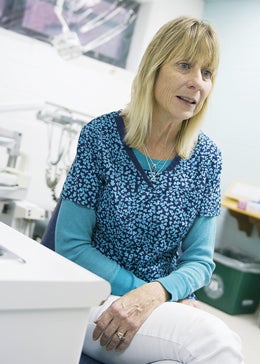 Bethany Waters’ mother was a dental assistant on U.S. Air Force bases. Waters took a similar, but slightly different path. She is a dental assistant for corrections, serving the entire population of prisoners.
Bethany Waters’ mother was a dental assistant on U.S. Air Force bases. Waters took a similar, but slightly different path. She is a dental assistant for corrections, serving the entire population of prisoners.
“I liked speech pathology and audiology, and I always knew I wanted to work with people with different kinds of special needs—not just physical,” Waters says. She has been at the prison for 14 years, and she is on a mission: “I want them to love their dentist!”
“You’ve got all these tattoos, what are you afraid of?”
For many prisoners, their visit to the on-site clinic is the only time they will see a dentist in their lives. Waters believes her open, friendly manner has made a difference in prisoner attitudes toward dentists. “I tell them we are not here to torture you, it’s not part of your sentence.”
On a more serious note, Waters says that drug use does tremendous damage to teeth. “Teeth are the barometer of the body. We try to not only provide cleanings and fillings, but also education about maintaining good dental health.” Waters urges inmates to take advantage of dental services while they are incarcerated, and provides them with lists of dental clinics that are federally funded so that newly released prisoners have the information they need to seek dental care in their communities. But, she acknowledges, this rarely happens.
“They joke with me when they return, which, unfortunately, is pretty likely,” she says. “They tell me they were arrested on their way to the dentist.”
Just two dental hygienists serve more than 3,000 prisoners annually, and Waters says that while it can be a daunting challenge, the rewards far outweigh the frustrations. Her clients are appreciative of the care they receive. “I am happy to say I have not become cynical in this job,” she says. “I am still empathetic to patients’ needs.”
Lynne Corry ’95 Deputy Warden, Women’s Prison
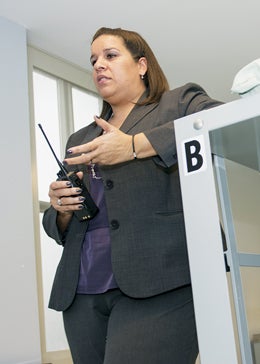 “I got bit.” Lynne Corry—referring to her internship at the R.I. Training School following graduation from URI—says working with youth in the guidance department and then teaching at the school cemented her passion for working in corrections.
“I got bit.” Lynne Corry—referring to her internship at the R.I. Training School following graduation from URI—says working with youth in the guidance department and then teaching at the school cemented her passion for working in corrections.
“Everyone deserves a second chance. I try to approach my work with no judgment.”
A stint doing assessments in the Women’s Prison for the Providence Center was followed by positions as a probation and parole officer and supervisor. Terry Smith (page 26) was Corry’s mentor. “She taught me you cannot take the disappointments personally,” Corry says.
Corry is a Talent Development Program grad and credits the program for helping her get through URI. And like Feliz, the experience made her want to give back. She was appointed deputy warden in 2014, and her responsibilities are significant. Overseeing the “mini-city” that is the Women’s Prison, Corry ensures that inmates are treated humanely, that the facility is safe, and that the 130 staff under her leadership can go home safely every night.
“This is a 24-hour, thankless business,” Corry says. “No one has a parade for the DOC, but we are the backbone of public safety.”
And for many prisoners, she adds, “We’re the most consistent thing in their lives. Their families have cast them aside after addiction has taken them to a bad place.”
That is why she is determined to provide opportunities for prisoners to experience success while they are incarcerated, so they have a better shot at staying out. And she knows rehabilitation is possible. Not long ago, an offender she had supervised early in her career approached her in the grocery store. He thanked Corry for saving his life. His wife added, “If it weren’t for you, I wouldn’t have this man and this baby. He stayed clean for you. You never abandoned him.”
Corry says not too much surprises her anymore, but the incident caught her off guard. “No one ever thanks me for putting them in prison,” she laughs.
Lisa Soderlund ’95 Adult Counselor, Medium Security
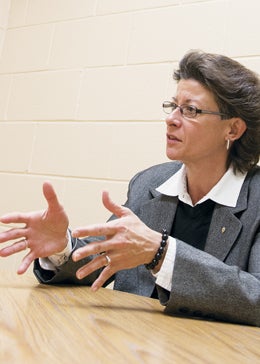 Even as a youngster, Soderlund says, “I had a thing about needing to fix broken people. I always brought home the strays.” She got into scrapes protecting a friend who was developmentally delayed: “I hated bullies.”
Even as a youngster, Soderlund says, “I had a thing about needing to fix broken people. I always brought home the strays.” She got into scrapes protecting a friend who was developmentally delayed: “I hated bullies.”
She’s seated at a table meant for attorney-client conversations, in a private room within the cafeteria-like visitor’s space at the John J. Moran Medium Security Facility, where her clientele currently includes some 150 inmates. After 19 years working in the ACI, she says the job can breed negativity, especially when a former patient succumbs to an overdose. But, she adds, “If I can influence just one person to straighten out, it’s worth it.”
“It’s frustrating, but not surprising, to see people coming back over and over. With a record, no skills, and no education, they go back to what they know.”
She traces her inspiration back to a psychology class, taught by a recovering addict, that she took at the URI College of Continuing Education. At the time she was doing a master’s in history, with plans to become a teacher. But the class, and a friend working in the field, opened her eyes to the possibility of counseling. Today Soderlund is a certified criminal justice professional; she also maintains a license in chemical dependency counseling.
In addition to coordinating the process for inmates to get into drug treatment programs, including screenings, assessments, placement, and counseling, Soderlund prepares prisoners for release and for parole board hearings. Winner of the DOC’s 2011 John J. Moran Award, which honors employee excellence and the rehabilitation of offenders, Soderlund is proud that her peers recognized her commitment and says the rewards outweigh the frustrations. When Soderlund bumps into someone doing well in the community, supporting himself legitimately and maintaining his recovery, she considers it a blessing.
To stay mentally and physically healthy, Soderlund does something positive for herself every day. And when released prisoners do return, Soderlund helps them to focus on the factors that brought them back. “We talk about what’s missing and what needs to happen. What were the holes in the cheese that caused the relapse? And how do we plug those holes?”
Terry Smith ’79 Probation and Parole Supervisor
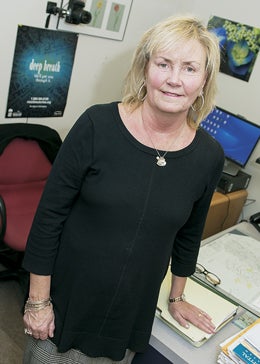 Thirty years total of experience in the Department of Corrections, the Department of Children, Youth, and Families, and Juvenile Probation, have not dampened Terry Smith’s enthusiasm. “I love what my staff do every day with offenders,” she says. “They are motivational interviewers, trying to break the cycle of drug abuse and connect people with what they need.”
Thirty years total of experience in the Department of Corrections, the Department of Children, Youth, and Families, and Juvenile Probation, have not dampened Terry Smith’s enthusiasm. “I love what my staff do every day with offenders,” she says. “They are motivational interviewers, trying to break the cycle of drug abuse and connect people with what they need.”
“Our role is to work with probationers and parolees so they can be their best where they are.”
Starting out as a child protective investigator, Smith also worked in the State Juvenile Division in Wakefield, as a probation officer for adults, in risk assessment in Cranston, and as a probation officer in the sex offender unit in Cranston. Today, Smith supervises parole and probation officers and staff in Newport and South County.
She explains the balancing act of probation and parole: “Rehabilitation is possible, but first and foremost we consider public safety. Sometimes we recommend incarceration, but we always weigh a number of important factors first, including what else is going on in offenders’ lives, how compliant they are, and the nature of the new charges.”
One of Smith’s proudest accomplishments has been her involvement in three of the state’s re-entry councils—in South Kingstown, Westerly (which she helped to launch), and Newport, which was the first in Rhode Island. The councils bring together law enforcement professionals, local service providers, community action programs, local chambers of commerce, discharge planners, and parole and probation supervisors to review plans for re-entering offenders. “We raise concerns about anything—housing situations, access to appropriate medications and mental health services, for example—that could trigger dangerous behavior,” she says. “The councils have created a much more seamless re-entry into the community.”
Smith says she has seen progress toward what she calls stopping the cycle of the revolving door. She commends transition programs within the prison walls, and notes that adult counselors like Soderlund have good systems of communication with parole and probation officers.
Another rewarding aspect of Smith’s job: when probationers or parolees become counselors themselves. “They are some of the best counselors we have. They have walked in the shoes of their clients.”
Laura Pisaturo ’91 Parole Board Chair
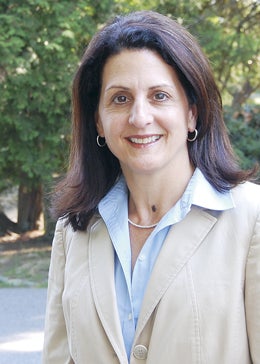 Laura Pisaturo did not seek to be appointed chair of the Rhode Island Parole Board, but she was delighted and honored when former Governor Lincoln Chafee appointed her in 2014.
Laura Pisaturo did not seek to be appointed chair of the Rhode Island Parole Board, but she was delighted and honored when former Governor Lincoln Chafee appointed her in 2014.
“Whatever hat I’ve worn, I have been an advocate.”
The Parole Board has broad discretion to determine when offenders will be released from prison. Pisaturo points out, “The paramount goal is public safety. We’re balancing many different elements, including the seriousness of the offense, rights of victims and the rights of offenders, some of whom may have the capacity for rehabilitation.”
A marriage-equality activist and attorney with more than 18 years of experience as a civil litigator and criminal prosecutor, Pisaturo was a state prosecutor under three state attorneys general, and a civil litigator with the law firm Hinckley, Allen & Snyder. As director of advocacy and legal services at Day One, the state’s sexual assault resource center, she led the Rhode Island Children’s Advocacy Center to its first national accreditation.
She intends to draw on her experience as a prosecutor, her work with the Rhode Island Supreme Court Disciplinary Board, and her long history of advocating for victims and the voiceless. “My advocacy for victims, the LGBTQ community, and for those who aren’t at the table but should be, reflects my commitment to equal justice under the law,” she says.
Pisaturo’s take on treatment programs for prisoners echoes the sentiments of others profiled here. “It’s challenging when we don’t have enough programs or opportunities within or outside of prison for offenders,” she points out. Managing an offender’s transition back into the community requires collaboration across local law enforcement, community service providers, and parole and probation officers. “It’s a complex task and a profound responsibility.”
Not Throwing Away the Key
Sixteen years ago, URI nursing professor Ginette Ferszt, a certified psychiatric clinical nurse specialist, never dreamed of volunteering in the Women’s Prison. But her early research led to her facilitation of a grief group, as a result of which she helped establish protocols for inmates to observe rites of mourning with dignity.
Former Warden Carol Dwyer approached Ferszt about assisting with the needs of the pregnant incarcerated. With URI College of Nursing colleague Debra Erickson-Owens, a certified nurse midwife, Ferszt developed a support group for these inmates, and the pair collaborated with doctoral student Rebecca Lebeau-Craven to create an educational packet now used by women’s prisons nationwide. Today, pregnant prisoners are identified by blue dots on their nametags and receive prenatal vitamins, extra evening snacks, and two mattresses for comfort during their second and third trimesters. Rhode Island is one of very few states to support breastfeeding. According to Ferszt, it takes teamwork and a visionary correctional administration to implement such progressive initiatives.
While Rhode Island has not shackled prisoners during childbirth for decades, Ferszt, in collaboration with Warden Dwyer, was instrumental in advocating for legislation to be passed and continues to work with nursing organizations in other states to encourage them to follow suit.
Integrating her research with her teaching, Ferszt actively engages undergraduate and graduate students in her work. Groups of nursing students select clinical practicums in the women’s and men’s facilities. They emerge with a keen appreciation of the stigmatization of people in prisons.
In 2012 and 2013, Ferszt traveled to Sweden on a Fulbright, and she praises the Swedes for investing in programs to build women’s skills so they are less likely to recidivate. She also visited a Norwegian women’s prison with a focused program: Prisoners sold handmade crafts and jewelry at a prison shop in a major city. Ferszt dreams of similar programming in Rhode Island. “When you feel you have something to offer, you can continue to have hope.”
Throwing the Book at Rhode Island Prisons
The stories that URI Sociology Professor Leo Carroll tells of his days as a captain in the military police at Fort Leavenworth, Kansas, in the late 1960s are harrowing. From boiling racial tensions to searing post-traumatic stress disorder and mental illness suffered by the Vietnam vets in his charge, Carroll witnessed events that changed him forever.
“I learned in a very real way it is difficult to be humane in a prison environment,” he says. “I am kind of an oxymoron: very far left of center politically, but in terms of prisons and other areas of life, I think where there are rules they should be reasonable and sensible, but also they should be enforced.”
Returning to Rhode Island to resume his doctoral studies in sociology at Brown, Carroll spent hours almost every day for 18 months observing and interviewing prisoners, guards, and the administration, and assessing their interactions and interrelationships. The result was his first book, Hacks, Blacks and Cons: Race Relations in a Maximum Security Prison. This participant observation study details how well-intentioned reforms facilitated the importation of racial conflict from the free community into the prison, plunging it into chaos and violence.
In 1978, the federal court in Palmigiano v. Garrahy declared conditions in the ACI constituted cruel and unusual punishment and entered a comprehensive remedial order. Carroll examined the ultimately successful 18-year struggle to implement that decree in a second, award-winning, book, Lawful Order: Correctional Crisis and Reform.
At URI, Carroll teaches courses including The Criminal Justice System, Police in Democratic Societies, Punishment and Corrections, and Policy Issues in Criminal Justice. He also coordinates the department’s internships. The professor has influenced the careers of Smith, Feliz, Corry, and many other alumni who serve on police forces and as state troopers around the country.
Today, despite the fact that there are more prisoners, the facilities at the ACI are much improved from those of 50 years ago, according to Carroll, who works closely with the Department of Correction’s Planning and Research unit. His fundamental purpose: to learn if best practices reduce recidivism. He’s “moderately optimistic” about progress on this front.
“The trend is toward a bleak future when you get out of prison,” he says. “To reverse that, you have to keep people away from drugs and alcohol. And you have to work to de-stigmatize the ex-cons by providing them with education and employment opportunities. We have to be willing to make the investment. We cannot afford to have people keep coming back.”
– Photos: Nora Lewis; courtesy Laura Pisaturo
 Home
Home Browse
Browse Close
Close Events
Events Maps
Maps Email
Email Brightspace
Brightspace eCampus
eCampus


